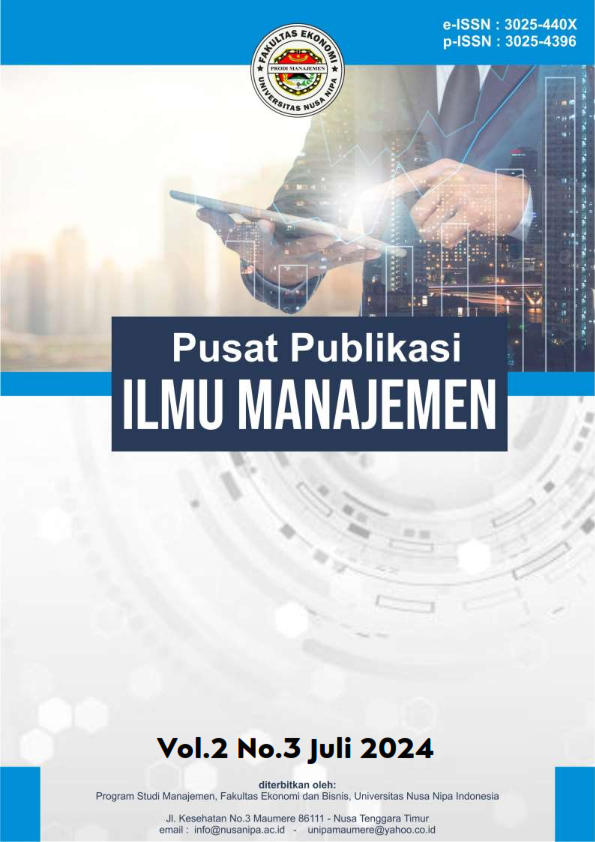Pengaruh Reward dan Punishment Terhadap Disiplin Waktu Kerja Karyawan pada CV Berkah Sukses Berjaya
DOI:
https://doi.org/10.59603/ppiman.v2i3.450Keywords:
Reward, Punishment, Employee Working Time DisciplineAbstract
In this research, researchers used the Slovin technique, the Slovin technique to calculate and determine samples accurately when conducting research in any field. Based on the results of Reward and Punishment research on work time discipline through simultaneous significant testing (F test), it turns out that there is a significant effect between Reward and employee work time discipline at CV Berkah Sukses Berjaya. It can be concluded that there is a joint influence between Reward and Punishment on employee work time discipline at CV Berkah Sukses Berjaya. The conclusions from the results of the research and discussion above are: 1. Reward Variable (X1) on Emploe Working Time Discipline (Y) seen from the coefficients table, the t value is 2.101, which means t count t table (2,101, 1,697) with a significance of 0.044, 0.05 . So the hypothesis which states that Rewards partially have a positive and significant effect on employee work time discipline can be accepted. 2. So it can be seen that the Punishment variable (X2) on Employee Working Time Discipline (Y) seen from the coefficients table, obtained a t value of 1.552, which means t count t table (1.552, 1.697) with a significance of 0.131, 0.05. So the hypothesis states that partial Punishment has no significant effect on employee work time discipline.
References
Ali, M., Arif, A., & Anggraini, D. (2017). Analisis kedisiplinan kerja karyawan di Kantin Maitreyawira Medan. Jurnal Manajemen Pemasaran, 386–392. https://semnas.univbinainsan.ac.id/index.php/escaf/article/view/144/21
Andy Pratama, M. F., & Putri Handayani, W. P. (2022). Pengaruh Reward Dan Punishment Terhadap Kinerja Karyawan. Jurnal Sosial Ekonomi Bisnis, 2(2), 62–70. https://doi.org/10.55587/jseb.v2i2.46
Hasdiana, U. (2018). No Title. Analytical Biochemistry, 11(1), 1–5. http://link.springer.com/10.1007/978-3-319-59379-1%0Ahttp://dx.doi.org/10.1016/B978-0-12-420070-8.00002-7%0Ahttp://dx.doi.org/10.1016/j.ab.2015.03.024%0Ahttps://doi.org/10.1080/07352689.2018.1441103%0Ahttp://www.chile.bmw-motorrad.cl/sync/showroom/lam/es/
Iriyani, N. (2022). Penerapan Disiplin Kerja Untuk Meningkatkan Efektivitas Kerja Karyawan Di Toko Nuansa Elektronik Martapura. 3. http://eprints.uniska-bjm.ac.id/11771/%0Ahttp://eprints.uniska-bjm.ac.id/11771/1/ARTIKEL Nur iriyani 18310283.pdf
Kognisi, P. K., Risiko, P., Jenis, D. A. N., Bidori, F., Puspitowati, L. I. dan I., Wijaya, I. G. B., Alifah, U., Artikel, I., Paedagoria, S. N., Anwar, I., Jamal, M. T., Saleem, I., Thoudam, P., Hassan, A., Anwar, I., Saleem, I., Islam, K. M. B., Hussain, S. A., Witcher, B. J., … alma. (2021). Title. Industry and Higher Education, 3(1), 1689–1699. http://journal.unilak.ac.id/index.php/JIEB/article/view/3845%0Ahttp://dspace.uc.ac.id/handle/123456789/1288
Rahmah, U. S., & Sari, R. K. (2023). Pengaruh Punishment Dan Reward Terhadap. JURNAL ECONOMINA Volume, 2(3).
Sabri, A. (2018). Efektivitas Fingerprint Dalam Meningkatkan Kedisiplinan Pegawai Di Dinas Pertanian Dan Perkebunan Aceh. 1–61. https://repository.ar-raniry.ac.id/9532/
Selatan, K. T. (n.d.). (5.332 > 2,018), artinya disiplin kerja memiliki pengaruh signifikansi terhadap kinerja pegawai.Motivasi memiliki t. 42–53.
Sitanggang, J. P., Manumono, D., & Listiyani. (2017). Pengaruh sangsi dan penghargaan terhadap kedisiplinan karyawan panen pada perkebunan kelapa sawit di PT Perkebunan Nusantara III Kanas Sumatera Utara. Jurnal Masepi, 2(1).
Suak, R., Adolfina, & Uhing, Y. (2017). Pengaruh Reward Dan Punishment Terhadap Kinerja Karyawan Sutanraja Hotel Amurang. Emba, 5(2), 1050–1059.
Tingkat Kehadiran Karyawan PT . Halaman Ide Indonesia 2018-2019. (2014). 2015, 1–9.
Winda, T., & Sri Astuti dkk. (2018). 14.Bab Ii. T Winda Sri Astuti Dkk, 2017, 15–29.
Additional Files
Published
How to Cite
Issue
Section
License
Copyright (c) 2024 PPIMAN Pusat Publikasi Ilmu Manajemen

This work is licensed under a Creative Commons Attribution-ShareAlike 4.0 International License.






